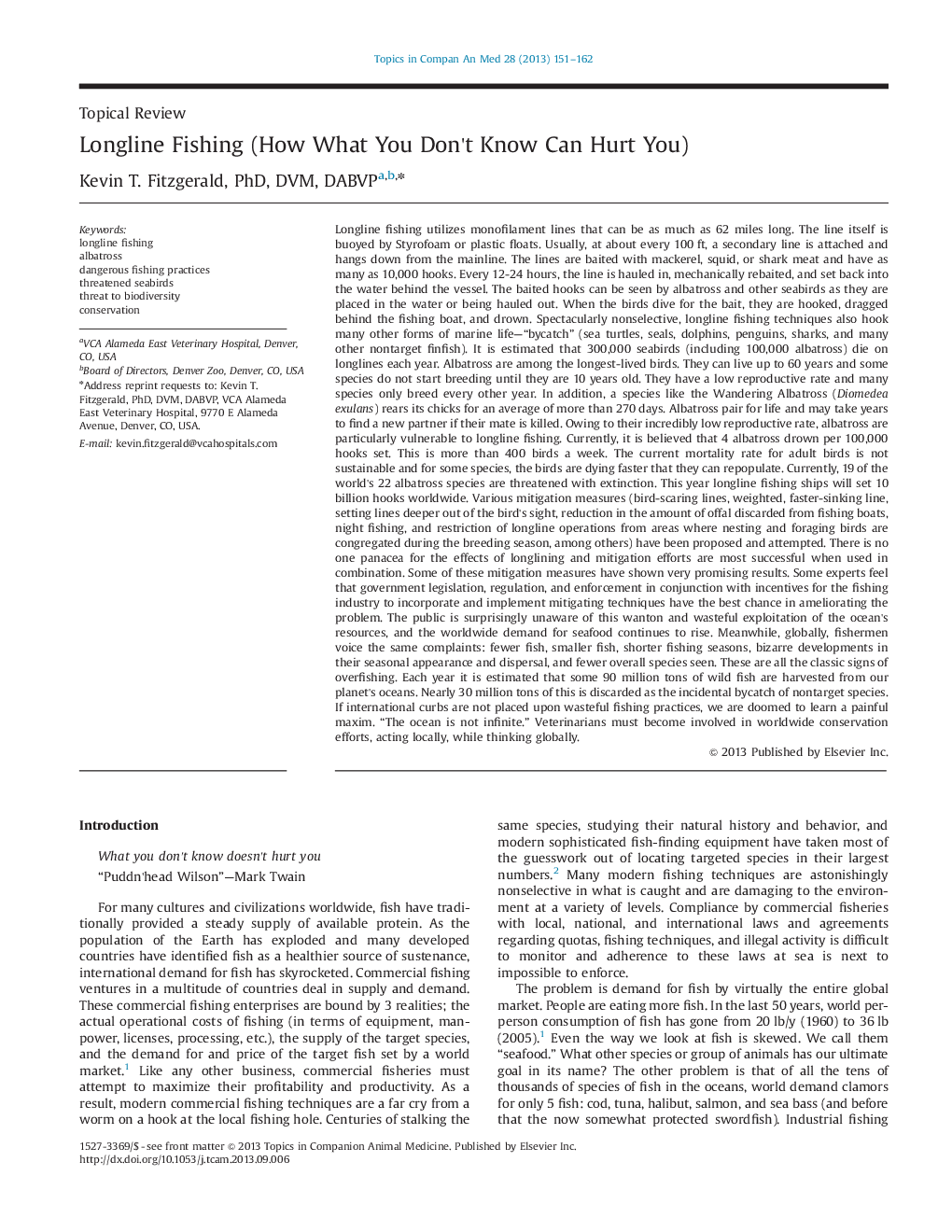| Article ID | Journal | Published Year | Pages | File Type |
|---|---|---|---|---|
| 2401136 | Topics in Companion Animal Medicine | 2013 | 12 Pages |
Abstract
Longline fishing utilizes monofilament lines that can be as much as 62 miles long. The line itself is buoyed by Styrofoam or plastic floats. Usually, at about every 100Â ft, a secondary line is attached and hangs down from the mainline. The lines are baited with mackerel, squid, or shark meat and have as many as 10,000 hooks. Every 12-24 hours, the line is hauled in, mechanically rebaited, and set back into the water behind the vessel. The baited hooks can be seen by albatross and other seabirds as they are placed in the water or being hauled out. When the birds dive for the bait, they are hooked, dragged behind the fishing boat, and drown. Spectacularly nonselective, longline fishing techniques also hook many other forms of marine life-“bycatch” (sea turtles, seals, dolphins, penguins, sharks, and many other nontarget finfish). It is estimated that 300,000 seabirds (including 100,000 albatross) die on longlines each year. Albatross are among the longest-lived birds. They can live up to 60 years and some species do not start breeding until they are 10 years old. They have a low reproductive rate and many species only breed every other year. In addition, a species like the Wandering Albatross (Diomedea exulans) rears its chicks for an average of more than 270 days. Albatross pair for life and may take years to find a new partner if their mate is killed. Owing to their incredibly low reproductive rate, albatross are particularly vulnerable to longline fishing. Currently, it is believed that 4 albatross drown per 100,000 hooks set. This is more than 400 birds a week. The current mortality rate for adult birds is not sustainable and for some species, the birds are dying faster that they can repopulate. Currently, 19 of the world's 22 albatross species are threatened with extinction. This year longline fishing ships will set 10 billion hooks worldwide. Various mitigation measures (bird-scaring lines, weighted, faster-sinking line, setting lines deeper out of the bird's sight, reduction in the amount of offal discarded from fishing boats, night fishing, and restriction of longline operations from areas where nesting and foraging birds are congregated during the breeding season, among others) have been proposed and attempted. There is no one panacea for the effects of longlining and mitigation efforts are most successful when used in combination. Some of these mitigation measures have shown very promising results. Some experts feel that government legislation, regulation, and enforcement in conjunction with incentives for the fishing industry to incorporate and implement mitigating techniques have the best chance in ameliorating the problem. The public is surprisingly unaware of this wanton and wasteful exploitation of the ocean's resources, and the worldwide demand for seafood continues to rise. Meanwhile, globally, fishermen voice the same complaints: fewer fish, smaller fish, shorter fishing seasons, bizarre developments in their seasonal appearance and dispersal, and fewer overall species seen. These are all the classic signs of overfishing. Each year it is estimated that some 90 million tons of wild fish are harvested from our planet's oceans. Nearly 30 million tons of this is discarded as the incidental bycatch of nontarget species. If international curbs are not placed upon wasteful fishing practices, we are doomed to learn a painful maxim. “The ocean is not infinite.” Veterinarians must become involved in worldwide conservation efforts, acting locally, while thinking globally.
Related Topics
Life Sciences
Agricultural and Biological Sciences
Animal Science and Zoology
Authors
Kevin T. PhD, DVM, DABVP,
